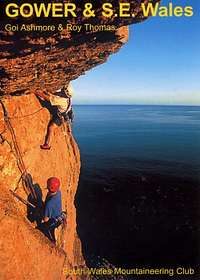Gower and South East Wales
Product Description
by Goi Ashmore and Roy Thomas
Published by South Wales Mountaineering Club
A completely updated and revised edition to this popular area in South Wales. As well as covering the Gower Peninsula it also features the inland limestone area surrounding Merthyr Tydfil and Abergavenny, and the weathered limestone sea cliffs around Bridgend including the well known Ogmor and Witches Point.



Nanuls - Apr 6, 2010 1:35 pm - Voted 3/5
Mixed FeelingsGower and South East Wales is a product of the South Wales Mountaineering Club’s work in documenting the crags in their local area, and in this respect, there can be no other group more qualified to dos so. It has clearly taken an enormous amount of work to record the thousands of trad and sport routes the area holds as well as to work out the various local conditions that affect them (mostly tides and bird bans). No stone has been left unturned (ahem) with crags ranging from popular limestone cliffs on the Gower to the esoteric sandstone quarries of the Valleys all finding some level of coverage. The book also contains well researched and written geology and history sections, which add further depth and interest to an already detailed publication.
The book does have its faults though. Its general presentation leaves something to be desired, particularly in light of new publications being produced by people such as the Climbers’ Club, Ground-Up and Rockfax. Maps are simple and not always helpful and topographic photographs or diagrams are limited to but a few crags. To be fair, Gower and South East Wales is not a new book, but Rockfax have been producing higher quality, albeit more limited, books since the mid 1990s. The book is also a weird size; it’s large and cumbersome and unless your wearing a jacket, doesn’t really fit into your pocket. Rockfax books suffer from the same problem, but being thinner than Gower and South East Wales, can at least be folded into a manageable size. A better option perhaps would have been to produce a twin books, one covering Gower and the other South East Wales, much in the same style of the Climber’s Club’s 1996 Pembroke guides.
The major issue the book has however is the way in which it describes some of the less visited crags. While popular areas are well described and consequently easy to find, the descriptions of more minor crags and routes are often short and unhelpful. Often has been the occasion where my partners and I have followed the directions of the book to find ourselves at a rock face which bears little resemblance to the provided description. Some might say that this is just my inability to interpret the text properly, but I have met many people while climbing who have had, or more often than not, are having, the same problem. Such instances are extremely frustrating when short on time and do not encourage one to explore the area beyond what they already know.
It is difficult to be too critical though. It’s important to remember that the book has been produced by volunteers of the South Wales Mountaineering club and not by a private company such as Rockfax or Ground-Up. It’s also important to remember that in the grand scheme of things, the club is a relatively small one and lacks the resources available to some the UK’s more senior bodies such as the Climbers’ Club and Scottish Mountaineering Club. In fact, the club been extremely innovative with their limited recourses and maintain an online guidebook in the form of a Wiki site, to be used in conjunction with this book. The advantage of this approach being that the club can provide climbers with up-to-date information as and when things happen. It also has the advantage of being a forum where the club can provide lots of photos of crags without having to go to the expense of printing them. Taken together, the book and the wiki make an excellent combination and one that I can heartily recommend to anyone thinking of visiting Wales for the purpose of climbing.